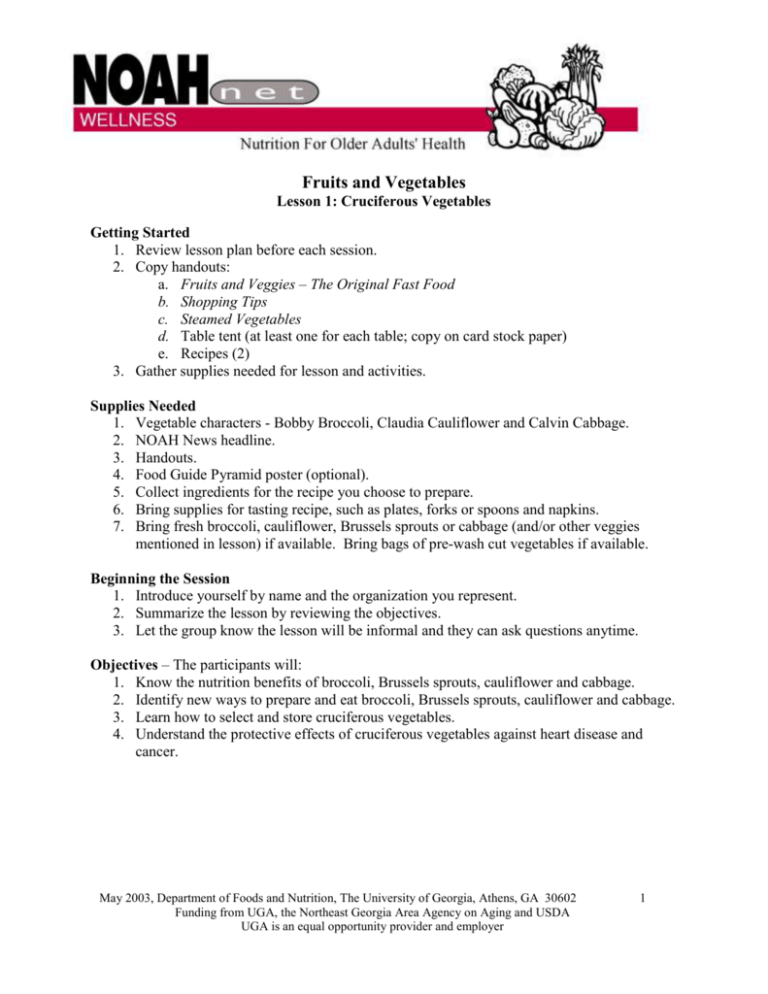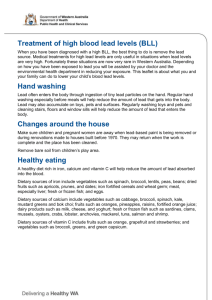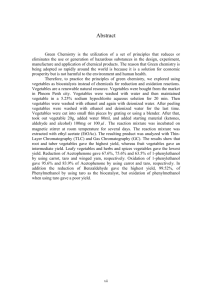Fruit and Vegetable - University of Georgia
advertisement

Fruits and Vegetables Lesson 1: Cruciferous Vegetables Getting Started 1. Review lesson plan before each session. 2. Copy handouts: a. Fruits and Veggies – The Original Fast Food b. Shopping Tips c. Steamed Vegetables d. Table tent (at least one for each table; copy on card stock paper) e. Recipes (2) 3. Gather supplies needed for lesson and activities. Supplies Needed 1. Vegetable characters - Bobby Broccoli, Claudia Cauliflower and Calvin Cabbage. 2. NOAH News headline. 3. Handouts. 4. Food Guide Pyramid poster (optional). 5. Collect ingredients for the recipe you choose to prepare. 6. Bring supplies for tasting recipe, such as plates, forks or spoons and napkins. 7. Bring fresh broccoli, cauliflower, Brussels sprouts or cabbage (and/or other veggies mentioned in lesson) if available. Bring bags of pre-wash cut vegetables if available. Beginning the Session 1. Introduce yourself by name and the organization you represent. 2. Summarize the lesson by reviewing the objectives. 3. Let the group know the lesson will be informal and they can ask questions anytime. Objectives – The participants will: 1. Know the nutrition benefits of broccoli, Brussels sprouts, cauliflower and cabbage. 2. Identify new ways to prepare and eat broccoli, Brussels sprouts, cauliflower and cabbage. 3. Learn how to select and store cruciferous vegetables. 4. Understand the protective effects of cruciferous vegetables against heart disease and cancer. May 2003, Department of Foods and Nutrition, The University of Georgia, Athens, GA 30602 Funding from UGA, the Northeast Georgia Area Agency on Aging and USDA UGA is an equal opportunity provider and employer 1 Script Introduction (Bring fresh cruciferous vegetables to display and refer to when describing these vegetables. Can also bring pre-washed bagged veggies to show convenience and price. Use these as prizes for participants to answer questions or give examples, etc.) Let’s take a look at our headline (display headline). What may be the secret to staying healthy and fit as we age? Eating 5 to 9 servings of colorful fruits and vegetables every day – 5 A Day the Color Way, our age-defying formula for health that may help: 1. Fight cancer. 2. Fight heart disease. 3. Fight effects of aging (on eyesight, memory, immune function and painful inflammation). Remember, if there is one thing certain about diet, it is that you may reduce your risk of cancer, heart disease and other conditions associated with aging if you eat at least 5 servings of colorful fruits and vegetables daily, as part of an overall diet low in saturated fat and cholesterol. So, how are all of you going to help yourself fight cancer, heart disease and other diseases of aging? Say it with me – 5 A Day the color way, eating 5 to 9 servings of colorful fruits and vegetables every day to stay healthy and fit (hold up handout/show overhead). Let’s review. What is the rainbow of colors for staying healthy and fit? Blue-purple – like blueberries, blackberries, raisins and eggplant Yellow-orange – like oranges, peaches, summer squash and sweet potatoes Red – like strawberries, cherries, tomatoes and red cabbage White – like bananas, onions, garlic and cauliflower Green – like grapes, kiwi, broccoli, cabbage, Brussels sprouts and spinach Just like the different colors of Lifesavers Candy represent different flavors, different colors of fruits and vegetables represent different flavors and different disease-fighting nutrients that may help you stay healthy and fit. That is why we need 5 A Day the Color Way! May 2003, Department of Foods and Nutrition, The University of Georgia, Athens, GA 30602 Funding from UGA, the Northeast Georgia Area Agency on Aging and USDA UGA is an equal opportunity provider and employer 2 We are going to talk about some of the green and white vegetables today – vegetables that may help reduce your risk of cancer and heart disease, help protect your eyes from cataracts and macular degeneration, and help keep bones and teeth strong. To get started, let me introduce you to my colorful veggie helpers today, Bobby Broccoli, Claudia Cauliflower and Calvin Cabbage. (Introduce these three members of the cruciferous vegetable family and display while you are talking. Tell the participants the vegetable’s name and ask the participants which of these vegetables they regularly eat, how often they eat them, which is their favorite, how they like to prepare them or if they eat them at all.) These three vegetables are from the cabbage or cruciferous vegetable family. Vegetables from the cruciferous family have flowers that form the shape of a cross. Isn’t that neat? Brussels sprouts, kale, collards, mustard greens and rutabagas are also cruciferous veggies. All these vegetables can help protect you from the diseases we listed. We will also look at many easy ways to prepare, cook and serve these vegetables that are healthy and taste great too! Let’s begin by learning about their nutrition benefits. Nutrition Benefits Broccoli, Brussels sprouts, cauliflower and cabbage should be known as nutrition superstars. These vegetables are rich in vitamin C and are good sources of folate and disease-fighting phytochemicals. Raise your hand if you know what phytochemicals can do for your body. (Let participants tell what they know about phytochemicals.) Phytochemicals are the natural plant compounds that give fruits and vegetables their deep, dark colors (dark green broccoli, red cabbage), and their distinctive odors (like cooked cabbage or cauliflower). They are the very things plants use to protect themselves from pests (or bugs/insects) and sun damage. They also protect us when we eat fruits and vegetables. In fact, they may be very strong disease fighters – or “phyters” – and help fight cancer, heart disease, cataracts, diabetes complications. They may also help slow the effects of aging on memory, immune function, and inflammation. The phytochemicals in broccoli, Brussels sprouts, cauliflower and cabbages may help reduce cancer risk and protect your heart. These vegetables are also rich in vitamin C, which we all need to help fight infections. You just need to eat them several times a week for these benefits! Vegetables and Fruits - The Original Fast Food What kinds of foods come to mind when I say fast food? (Allow time for answers) What about vegetables? Why not! While most people may visit the vending machine or a fast food restaurant when they want quick, cheap food, they may pay the price in the long run. It is not cheap to treat obesity, heart disease, cancer, high blood pressure or diabetes. Think about it this way, “Those who think they have no time for healthy eating will sooner or later have to find time for illness,” (attributed to Edward Stanley, 1826-1893, from the Conduct of Life). That is something to think about! May 2003, Department of Foods and Nutrition, The University of Georgia, Athens, GA 30602 Funding from UGA, the Northeast Georgia Area Agency on Aging and USDA UGA is an equal opportunity provider and employer 3 Vegetables and fruits are nature’s original fast food anyway. Think how easy it is to keep fresh fruit in the house – just grab and eat for a snack, no waiting. Vegetables are easy, also. From frozen to canned veggies for quick cooking, to bags of baby carrots and other cut vegetables, and bags of pre-washed salad greens, your quick, easy choices are many (show examples of these types of convenient vegetables/fruits). Eating 5 A Day the Color Way can be quick and easy if you keep these foods on hand. Now, let’s look at some ways you can eat broccoli, Brussels sprouts, cabbage, and cauliflower. (Refer to Fruits and Veggies – The Original Fast Food handout.) 1. Microwave or steam fresh or frozen broccoli, cauliflower or Brussels sprouts and serve as a side dish. Sprinkle with 1 Tbsp shredded cheese or melted cheese for extra flavor. Season with 1 Tbsp each of olive oil and lemon juice for zesty flavor. 2. Serve raw broccoli and cauliflower florets with dip for a snack or appetizer. 3. Make a tortilla wrap or burrito with cooked shredded cabbage and other vegetables. 4. Use frozen broccoli, cauliflower, carrot blend vegetables in a stir-fry. Serve with cooked rice or on top of cornbread. 5. Marinate thawed broccoli-cauliflower blend vegetables in Italian salad dressing and serve as a side dish or vegetable salad. 6. Buy pre-cut fresh broccoli and cauliflower when on sale for quick recipes. 7. Top hot baked potatoes with cooked broccoli and 1 Tbsp of melted cheese. 8. Buy pre-shredded cabbage for quick slaw or to add to soups or casseroles. Shopping Tips - Buying Fresh Produce (Refer to Shopping Tips handout) Broccoli: Good quality fresh broccoli will have fresh-looking, firm, light green stalks. The florets will be tightly closed and have a dark green to bluish-green color. Florets that are starting to open and look yellowish are old and will not taste good. Brussels Sprouts: Fresh Brussels sprouts should be firm and green with tightly closed leaves. Avoid if leaves are yellow or have dark spots. Do not overcook to avoid a bitter taste. Cabbage: Cabbage is a great buy in cooler months when other vegetables are in limited supply. Choose evenly colored, heavy, firm heads. Leaves should be tightly packed together and fairly smooth. Avoid if leaves appear wilted. May 2003, Department of Foods and Nutrition, The University of Georgia, Athens, GA 30602 Funding from UGA, the Northeast Georgia Area Agency on Aging and USDA UGA is an equal opportunity provider and employer 4 Cauliflower: Choose cauliflower that is creamy white with firm, compact florets and bright green leaves. Avoid cauliflower with lots of dark spots and wilted, yellow leaves. Remember, frozen broccoli, Brussels sprouts and cauliflower are available year round, are just as nutritious, and are easy to prepare for a quick side dish. Storing Fresh Produce Vegetables will stay fresh longer if properly stored. Broccoli, Brussels sprouts, cauliflower and cabbage should be stored in your refrigerator’s vegetable crisper. Do not wash before storing. You can also store these in a plastic bag in the refrigerator. Cabbage may stay fresh in the refrigerator for up to 2 weeks. The rest will stay fresh for up to 5 days. Store pre-cut, prewashed bags of vegetables in the original bag. This bag is designed to keep produce fresh much longer. Washing and Trimming Produce Wash these vegetables under cool, running water. Use a colander or strainer for easier washing. (Can demonstrate the following if desired, especially if you demonstrate how to steam vegetables.) Broccoli: Trim large leaves and remove tough ends of stalks. Cut broccoli head into spears or florets. Peel the remaining stalks and cut into even sized pieces and cook with spears or florets. Brussels Sprouts: Remove loose or discolored leaves. Cut off stem ends, careful to leave head intact. Cut any large sprouts in half before cooking. Cauliflower: Remove leaves and cut off stalk. Cut and separate into even-sized florets or leave head whole to cook. Cabbage: Remove outer leaves and cut out core. Then cut into 4 wedges or shred before cooking. Activity/Review (Demonstrate in kitchen area if available, or demonstrate steps with supplies, with veggies prepared in advance. Alternately, prepare another recipe in advance and let participants taste. Refer to Steaming Vegetables handout.) How many of you have tried steaming vegetables? Microwaving vegetables? Both are quick and easy ways to prepare vegetables and not loose as many nutrients. First, you need a pot with a lid and steamer basket (or a metal colander that fits in a pot, but does not touch the bottom). Place the vegetables in a steamer basket or a colander. Add about ½ inch of water in a pot (or enough so water does not touch bottom of steamer basket or colander). You can add dried herbs, pepper flakes, or lemon/orange slices to season the water. You can also use broth instead of water. Place steamer basket of vegetables in pot and cover with lid. Cook at high heat until May 2003, Department of Foods and Nutrition, The University of Georgia, Athens, GA 30602 Funding from UGA, the Northeast Georgia Area Agency on Aging and USDA UGA is an equal opportunity provider and employer 5 boiling. Then lower heat to low and cook until vegetables are crisp tender (refer to timetable in handout). Cook each vegetable about 2 minutes longer, or as needed, if more a tender vegetable desired (more nutrients lost with longer cooking). Be careful when you remove the steamed vegetables from the pot. Pour into a serving dish and season. A mixture of 1 Tbsp of lemon juice, 2 tsp olive oil, butter or margarine, ground pepper and herbs season these vegetables nicely (use salt in small amounts if desired). You can also top hot, steamed vegetables with a small amount of shredded cheese. Okay, let’s review before we try a tasty recipe. 1. How many servings of fruits and vegetables do you need to eat daily? At least 5 a day. 2. What can eating colorful cruciferous vegetables do for you? Help you stay healthy and fit – reduce risk of heart disease and cancer, etc. References Duyff, R.L. The American Dietetic Association’s Complete Food & Nutrition Guide. Minneapolis, 1996. Eat Your Colors. The Produce for Better Health Foundation. 31 Mar 2003 <http://www.5aday.com>. Joseph, J. A., Nadeau, D.A. & Underwood, A. The Color Code – A revolutionary plan for optimum health. New York, 2002. Kurtzweil, P. Fruits and Vegetables: Eating Your Way to 5 A Day. FDA Consumer. March 1997. 9 May 2003 <http://www.fda.gov/fdac/features/1997/297_five.html>. Produce A – Z. AboutProduce.Com. 31 Mar 2003 <http://www.aboutproduce.com/>. Salads. All Recipes. 8 May 2003 <http://salad.allrecipes.com/>. The Food Stamp Program provides nutrition assistance to people with low income. It can help buy nutritious foods for a better diet. To find out more, contact your local food stamp office, food bank, or senior center. Primary authors: Karen Coffman, RD, LD & Marilyn O. Wright, MS, RD, LD NOAHnet@uga.edu Primary reviewers: Joan G. Fischer, PhD, RD, LD & Mary Ann Johnson, PhD Graphic artist: Wendy Gout May 2003, Department of Foods and Nutrition, The University of Georgia, Athens, GA 30602 Funding from UGA, the Northeast Georgia Area Agency on Aging and USDA UGA is an equal opportunity provider and employer 6 This material, including artwork, was developed with support from the Department of Foods and Nutrition at The University of Georgia, the Northeast Georgia Area Agency on Aging and the USDA Food Stamp Nutrition Education Program. Permission is granted to reproduce, translate, abstract, review or quote these materials in whole or in part for educational purposes only (not for profit beyond the cost of reproduction) provided that the author(s) and The University of Georgia receive acknowledgement as shown in this example notice: Reprinted with permission from The University of Georgia, Department of Foods and Nutrition, Athens, GA. Authors, Title, Date. May 2003, Department of Foods and Nutrition, The University of Georgia, Athens, GA 30602 Funding from UGA, the Northeast Georgia Area Agency on Aging and USDA UGA is an equal opportunity provider and employer 7 Cabbage Casserole 1 pound lean ground beef 1 medium onion, chopped 3 cups shredded cabbage ½ cup uncooked rice 1 (8 oz) can tomato sauce 1 cup water 1. Heat oven to 350 degrees. Meanwhile, brown ground beef and onion in skillet over medium-high heat until done. Drain the beef mixture to remove as much grease as possible and place in medium baking dish. 2. Spread the shredded cabbage evenly over beef mixture. Sprinkle rice over cabbage and then add the tomato sauce and water. 3. Bake in oven until most of the liquid is absorbed and rice is tender, about 50 minutes. Let sit about 5 minutes before serving. This dish is hearty enough to be a meal itself. If desired, served with stewed or steamed summer squash and fruit salad. Nutrition Facts per serving: Calories Total fat Total carbohydrate Serving size: 1 cup 193 8g 18 g Adapted from The New Soul Food Cookbook for People with Diabetes, by F. D. Gaines & R. Weaver May 2003, Department of Foods and Nutrition, The University of Georgia, Athens, GA 30602 Funding from UGA, the Northeast Georgia Area Agency on Aging and USDA UGA is an equal opportunity provider and employer 8 Broccoli Slaw 1 package (10 oz) chopped or shredded broccoli ½ cup dried cranberries or raisins ½ cup chopped nuts ½ to 1 cup coleslaw dressing Salt & pepper to taste 1. Combine broccoli, cranberries, nuts, salt and pepper in medium bowl. 2. Stir in enough dressing to moisten mixture. Cover and refrigerate until ready to serve. Makes 5 servings. Nutrition Facts per serving: Calories Total fat Total carbohydrate Serving size: ½ cup (1/5 recipe) 328 23 g 27 g © Allrecipes.com. Used with permission http://www.phs.org/healthyliving/recipes/2000/potluck.htm May 2003, Department of Foods and Nutrition, The University of Georgia, Athens, GA 30602 Funding from UGA, the Northeast Georgia Area Agency on Aging and USDA UGA is an equal opportunity provider and employer 9 Fruits and Veggies – The Original Fast Food 5 A Day the Fast & Easy Color Way Microwave or steam fresh/frozen broccoli, cauliflower or Brussels sprouts and serve as a side dish. Toss cooked vegetables with 1 Tbsp each olive oil and lemon juice for zesty flavor. Top cooked vegetables with 1 Tbsp melted cheese or 1 Tbsp shredded cheese for extra flavor. Serve raw broccoli and cauliflower florets with dip for a snack or appetizer. Make a tortilla wrap or burrito with cooked shredded cabbage, other vegetables and cheese. Use frozen broccoli, cauliflower and carrot blend vegetables in a stir-fry. Serve with cooked rice or on top of cornbread. Top hot baked potatoes with cooked broccoli and 1 Tbsp melted cheese. Buy pre-cut packages of broccoli and cauliflower when on sale for quick recipes. May 2003, Department of Foods and Nutrition, The University of Georgia, Athens, GA 30602 Funding from UGA, the Northeast Georgia Area Agency on Aging and USDA UGA is an equal opportunity provider and employer 11 Selecting and Storing Produce Broccoli Firm, light green stalks. Bluish-green florets, tightly closed. Brussels Sprouts Firm, green heads. Tightly closed leaves, no yellow color. Cabbage Great buy in cooler months. Evenly colored, firm heads with tightly packed leaves. Cauliflower Creamy-white heads with bright green leaves. Compact florets without dark spots. Storing Vegetables Store these vegetables in your refrigerator’s crisper bin and use within a few days for better quality. Wash vegetables under cool, running water before using; do not wash before storing. Keep pre-cut, pre-washed bagged vegetables and salads in original bag once opened. Remember, frozen vegetables are available year round, are just as nutritious, and easy to prepare for a quick side dish. May 2003, Department of Foods and Nutrition, The University of Georgia, Athens, GA 30602 Funding from UGA, the Northeast Georgia Area Agency on Aging and USDA UGA is an equal opportunity provider and employer 12 Steamed Vegetables Quick and Easy 5 A Day the Color Way Vegetables (2 Servings) Fresh Vegetables Broccoli ½ head (¾ lb) in spears or florets Steaming Time Brussels sprouts ½ lb 20 – 25 minutes (¼ cup water) 8 – 11 minutes Cabbage ½ head (2 wedges) 18 – 24 minutes (¼ cup water) 10 – 14 minutes Cabbage ½ head, shredded 5 – 7 minutes (¼ cup water) 8 – 10 minutes Cauliflower ½ head (1 lb) in florets 6 – 8 minutes (¼ cup water) 12 – 14 minutes Frozen Vegetables 2 cups Reduce steaming times by half Per package directions 10 – 11 minutes Microwave Time (High) (½ cup water) 9 – 11 minutes May 2003, Department of Foods and Nutrition, The University of Georgia, Athens, GA 30602 Funding from UGA, the Northeast Georgia Area Agency on Aging and USDA UGA is an equal opportunity provider and employer 13 Steaming directions 1. Use a pot with a lid and a steamer basket or metal colander. 2. Fill pot with ½ inch of water and place steamer basket inside. Make sure water does not touch bottom of steamer. Add herbs, red pepper flakes, or lemon or orange slices to season water, if desired. Can also use broth instead of plain water. 3. Place vegetables in steamer basket. Cover with lid and cook at high heat until boiling. Reduce heat to low and cook for time listed in chart, until crisp tender. 4. Removed steamed vegetables from pot (be careful with steam) and place in serving bowl. 5. Season as desired and serve hot. Microwave directions 1. Place vegetables in microwave-safe dish with a lid. 2. Add the amount of water listed in chart and cover. 3. Microwave for amount of time listed in chart, rotating dish if oven does not have turntable. 4. Season as desired and serve hot. Suggested seasonings 1. Combine 1 Tbsp lemon juice with 2 tsp olive oil (or butter or margarine). Drizzle over hot vegetables. Add ½ tsp dried herbs or 2 tsp fresh herbs, if desired. 2. Top vegetables with 1 Tbsp melted cheese or 1 Tbsp of shredded cheese. 3. Toss with prepared Italian salad dressing or other vinaigrette. Adapted from Betty Crocker’s Cookbook: Everything You Need to Know to Cook Today. May 2003, Department of Foods and Nutrition, The University of Georgia, Athens, GA 30602 Funding from UGA, the Northeast Georgia Area Agency on Aging and USDA UGA is an equal opportunity provider and employer 14







